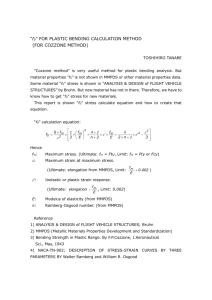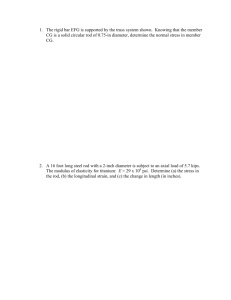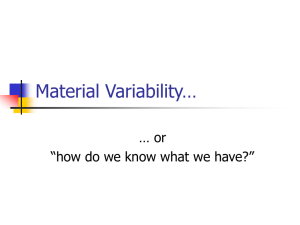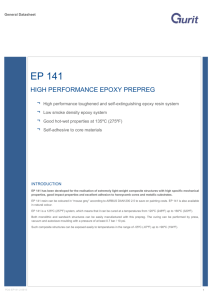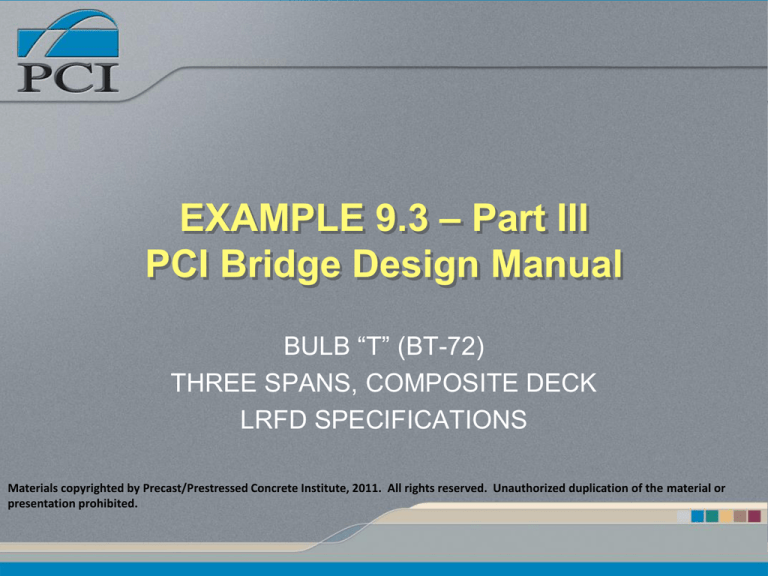
EXAMPLE 9.3 – Part III
PCI Bridge Design Manual
BULB “T” (BT-72)
THREE SPANS, COMPOSITE DECK
LRFD SPECIFICATIONS
Materials copyrighted by Precast/Prestressed Concrete Institute, 2011. All rights reserved. Unauthorized duplication of the material or
presentation prohibited.
TRANSFER AND
DEVELOPMENT LENGTH
• Stress is transferred from the steel to
the concrete through bond.
• TRANSFER LENGTH is the bonded
length needed to develop service level
stresses in the steel, fpe.
• DEVELOPMENT LENGTH is the
bonded length needed to develop the
maximum stress in the steel, fps.
TRANSFER AND
DEVELOPMENT LENGTH
This diagram
illustrates
transfer and
development
length.
Transfer length
is 60 bar
diameters.
TRANSFER AND
DEVELOPMENT LENGTH
tr
d
60d b
2
fps fpe d b
3
fps = stress in the steel at the strength limit state
fpe = stress in the steel at the service limit state
after all losses
db = bar (strand) diameter
TRANSFER AND
DEVELOPMENT LENGTH
is a factor
= 1.0 for prestressed panels, piles or
pretensioned members < 24 inched deep
= 1.6 for pretensioned members > 24 inches
deep.
Transfer length will be needed for release and
service level stresses calculations.
Development length will be calculated later.
STRESS AT RELEASE
Stresses due to loads are
usually linear or parabolic
as a function of length.
Stresses from straight
strands are constant over
the length.
At the ends, tensile
stresses can develop on
top.
LRFD does not allow this
cracking.
STRESS AT RELEASE
This situation is most
critical at the time
when prestressing
forces are first
applied.
At this time, the
prestressing force is
highest, the concrete
is weaker and only
beam DL is applied.
STRESS AT RELEASE
Definition:
Precompressed
tensile zone:
The side of the beam
precompressed by
the prestressing, but
which may
eventually have
tensile stresses due
to applied loads.
In this figure, the
precompressed tensile
zone is the BOTTOM.
STRESS AT RELEASE
LRFD Table 5.9.4.1.2-1
limits tensile stresses in
areas NOT in the
precompressed tensile
zone.
With bonded steel:
ft 0.24 fci '
Without bonded steel:
ft 0.0948 fci '
ft 0.2ksi
STRESS AT RELEASE
LRFD Table
5.9.4.1.2-1 also
limits compressive
stresses in the
precompressed
tensile zone.
fc < 0.6fci’
STRESS AT RELEASE
Transfer Length = 60db = 60(0.5”) = 30” = 2.5’
Self weight moment at transfer length:
wx
Mg
L x
2
0.799k / ft 2.5ft
Mg
119ft 2.5ft
2
Mg 116.4k ft 1397k in
This calculation uses the overall length of 119’ as it is
assumed the beam cambers up on release and sits on
its ends.
STRESS AT RELEASE
Top @ Transfer Length
Mg
Pi Pe
i
ft
A St
St
The stress calculation requires Pi. This is the same Pi
as for elastic shortening, ES.
The loss due to ES was found to be approx. 9%.
Pi = 44 strand(0.153in2/strand)(0.91)(202.5ksi)
Pi = 1241 kips
STRESS AT RELEASE
Top @ Transfer Length
Pi Pi e Mg
ft
A St
St
1241k (1241k )30.78" 1397 k in
2
3
3
767 in
15421in
15421in
0.768 ksi
Limit 0.24 fci ' 0.24 5.5
0.563 ksi NO GOOD
Limit assumes bonded reinforcement
Tensile stress is negative (-).
STRESS AT RELEASE
Bottom @ Transfer Length
Pi Pi e Mg
fb
A Sb Sb
1241k (1241k )30.78" 1397 k in
2
3
3
767 in
14915 in
14915 in
4.09 ksi
Limit 0.6fci ' 0.6(5.5)
3.30 ksi NO GOOD
CONTROLLING TOP TENSION
• Debond strand
– Some strands are coated with plastic so
they don’t bond.
– This reduces top tension by reducing P at
the end of the beam.
• Harp Strand
– Strand is deflected or HARPED.
– Changes “e”.
– This example harps strand.
CONTROLLING TOP TENSION
Photos of Harped Strand
CONTROLLING TOP TENSION
Harping strands: Number of harped strand is
determined by trial and error. Harp 12 strands as
shown. Harp at 0.3L. The harp point is arbitrary and
chosen by the engineer.
CONTROLLING TOP TENSION
The harp point, chosen by the engineer (usually by state
standard, experience or trial and error), is 35 ft. 6 inches
from the end of the beam.
CONTROLLING TOP TENSION
To calculate stresses, the value of “e” is needed. To
calculate e, the location of the centroids of the various
strand groups are needed.
CONTROLLING TOP TENSION
Find the centroid of the harped strands from the
top at the end of the beam:
2[2 4 6 8 10 12]
ct
7in
12
Find the centroid of the harped strands from the bottom
at the harp point:
2[6 8 10 12 14 16]
cb
11in
12
CONTROLLING TOP TENSION
Distance from the bottom of the beam to the centroid of the
non-harped strands
12(2) 12(4) 6(6) 2(8)
cb
3.88in
32
CONTROLLING TOP TENSION
72" 7" 11"
o
Arc tan
7.22
35.5'(12"/
ft
)
sin 0.1258
cos 0.9921 1
When calculating the stress due to prestressing, the
horizontal force in harped stands is Pcos, but the cos
is approximately 1, so horizonatl force in the harped
strands is taken as P.
CONTROLLING TOP TENSION
At the transfer length (2.5’ from the end), the distance
from the top of the beam to the centroid of the harped
strand is:
ct tr
2.5 '
7
(65" 11") 10.8in
35.5 '
CONTROLLING TOP TENSION
At the transfer length, the distance from the centroid
of all the strands to the bottom of the beam and the
eccentricity are:
cb tr
12(72" 10.8") 32(3.88")
19.51in
44 strands
etr 36.60" 19.51" 17.09in
STRESS AT RELEASE –
Top @ Transfer Length
Pi Pi e Mg
ft
A St
St
1241k (1241k )17.09" 1397 k in
2
3
3
767 in
15421in
15421in
0.334 ksi
Limit 0.6fci ' 0.6(5.5 ksi )
3.300 ksi OK
Limit is compressive because stress is now
compressive!!!
STRESS AT RELEASE –
Bottom @ Transfer Length
Pi Pi e Mg
fb
A Sb Sb
1241k (1241k )17.09" 1397 k in
2
3
3
767 in
14915 in
14915 in
2.95 ksi
Limit 0.6fci ' 0.6(5.5 ksi )
3.30 ksi OK
STRESS AT RELEASE –
Top @ Harp Points
Mg = 0.5(0.799k/ft)(35.5’)(119’-35.5’) = 1184 k-ft = 14210 k-in
Pi Pi e Mg
ft
A St
St
1241k (1241k )30.8" 14210 k in
2
3
3
767 in
15421in
15421in
0.062 ksi
Limit 0.6fci ' 0.6(5.5 ksi )
3.300 ksi OK
STRESS AT RELEASE –
Bottom @ Harp Points
Pi Pi e Mg
fb
A Sb Sb
1241k (1241k )30.8" 14210 k in
2
3
3
767 in
14915 in
14915 in
3.226 ksi
Limit 0.6fci ' 0.6(5.5 ksi )
3.30 ksi OK
STRESS AT RELEASE –
Top @ Midspan
Mg = 0.5(0.799k/ft)(59.5’)(119’-59.5’) = 1414 k-ft = 16970 k-in
Pi Pi e Mg
ft
A St
St
1241k (1241k )30.8" 16970 k in
2
3
3
767 in
15421in
15421in
0.242 ksi
Limit 0.6fci ' 0.6(5.5 ksi )
3.300 ksi OK
STRESS AT RELEASE –
Bottom @ Harp Points
Pi Pi e Mg
fb
A Sb Sb
1241k (1241k )30.8" 16970 k in
2
3
3
767 in
14915 in
14915 in
3.041ksi
Limit 0.6fci ' 0.6(5.5 ksi )
3.30 ksi OK
STRESS AT RELEASE
Distance from Top Stress
end of beam
ft ksi
Bottom Stress
fb ksi
At Transfer
Length 2.5’
+0.334
+2.946
At Harp Points +0.062
35.5’
+3.226
At Midspan
59.5’
+3.041
+0.242
All stresses compressive. Limit = 0.6fc’=3.30 ksi
STRESS AT RELEASE
This graph
shows the
stress at the
bottom of the
beam (precompressed
tensile zone)
along the
entire length.
It compares
straight
strands to
harped.
STRESS AT RELEASE
This graph
shows the top
stress and
compared
straight and
harped strand.
Note that
compression
is (+) and
tension is (-).
Harping
eliminates
tensile stress
at release.
SERVICE LEVEL STRESSES
• Unlike reinforced concrete, prestressed
concrete is checked under service
stresses.
• Service I applies to the compression
side of the beam and to the slab.
– Slab stress almost never controls
• Tension in the precompressed tensile
zone is governed by Service III.
SERVICE LEVEL STRESSES
A quick reminder of unfactored moments:
SERVICE LEVEL STRESSES
• Only the prestressed beam is subject to
service level stresses.
• The NEGATIVE moment area is a
REINFORCED member, so it is NOT
subject to service load checks.
• Only the positive moment areas need
be checked.
• Midspan is critical.
SERVICE LOAD STRESS – Bottom of
Girder Midspan – All Loads (Service III)
A quick reminder:
fbot
Ppe
A
Ppee
Sb
M g Ms
Sb
Mws Mb 0.8MLL I
Sbg
Ppe 1072kips
Limit 0.19 fc ' 0.19 7 ksi
0.504 ksi OK
SERVICE LOAD STRESS – Bottom of
Girder Midspan – All Loads (Service III)
fb
Ppe
A
Ppe e
Sb
M g Ms
Sb
Mws Mb 0.8MLL I
Sbg
1072k (1072 k )30.8 " (16970 25523) k in
2
3
767 in
14915 in
14915 in 3
(1536 876)k in
25380 k in
0.8
3
20545 in
20545 in 3
0.343 ksi
Limit 0.19 fc ' 0.19 7 ksi
0.504 ksi OK
SERVICE LOAD STRESS – Top of Girder
Midspan – Permanent Loads (Service I)
ft
Ppe
A
Ppe e
St
M g Ms
St
Mws Mb
Stg
1072k (1072 k )30.8 "
2
3
767 in
15421in
(16970 25523) k in (1536 876)k in
3
3
15421in
79400 in
2.04 ksi
Limit 0.45fc ' 0.45(7.0 ksi )
3.150 ksi OK
SERVICE LOAD STRESS – Top of
Girder Midspan – All Loads (Service I)
ft
Ppe
A
Ppee
St
M g Ms
St
Mws Mb MLL I
Stg
25380 k in
2.04 ksi
2.36 ksi
3
79400 in
Limit 0.6fc ' 0.6(7.0 ksi )
4.200 ksi OK
SERVICE LOAD STRESS – Top of Slab
Midspan – Permanent Loads (Service I)
Mws Mb
ftc
Stc
(1536 876)k in
0.035 ksi
3
68180in
Limit 0.45fc ' 0.45(4.0 ksi )
1.80 ksi OK
SERVICE LOAD STRESS – Top of Slab
Midspan – All Loads (Service I)
Mws Mb MLL I
ftc
Stc
25380 k in
0.035 ksi
0.407 ksi
3
68180 in
Limit 0.6fc ' 0.6(4.0 ksi )
2.400 ksi OK
SUMMARY OF SERVICE
LOAD STRESSES
Top of Deck (ksi) Top of Beam (ksi) Bottom
Service I
Service I
(ksi)
Serv.III
Permanent All
Loads
Loads
At
Midspan
+0.035
Allowable +1.800
(ksi)
Permanent All
Loads
Loads
All
Loads
+0.407 +2.05
+2.36
-0.343
+2.400 +3.150
+4.200
-0.504
Service Load Stresses in Beam
4
Shaded areas are (-) moment
3.5
3
Top Stress, All Loads
Limit 4.2 ksi
Stress (ksi)
2.5
2
1.5
Top Stress, Sustained Loads
Limit 3.15 ksi
1
0.5
Compression
0
Tension
-0.5
Bottom Stress; Limit -0.504 ksi
-1
0
12
24
36
48
60
72
Beam Length c/c Bearing (ft)
84
96
108
Service Load Graph
• If the bottom stress is COMPRESSIVE,
use Service I.
• The total service moments are 0 at
about 13 feet from the center of bearing
on each end. The negative moment
area, from center of bearing to 13 feet
on each end should be considered as
reinforced, not prestressed.
FATIGUE
Maximum moment for fatigue truck, one lane:
1032 k-ft.
No lane load.
Divide by Multiple Presence Factor of 1.2.
IM = 15%
DFone lane = 0.596 lanes/beam
Mfatigue = 1032 k-ft/lane(0.596
lanes/beam)(1.15)/1.2
Mfatigue = 589.5 k-ft = 7073 k-in
FATIGUE
• Fatigue uses a single truck, rear axles
spaced at 30 ft. and no lane load.
– 3.6.1.4.1
• Fatigue Truck uses 1 lane DF.
– 3.6.1.4.3b
• Remove Multiple Presence Factor
– 3.6.1.1.2
FATIGUE
Fatigue stress + ½ the stress at top of girder due
to prestressing and permanent load:
1 Ppe Ppee Mg Ms
ft
2 A
St
St
Mfatigue IM
Stg
7973k in
1.03 ksi
1.12 ksi
3
79400 in
Limit 0.4fc ' 0.4(7.0 ksi )
2.8 ksi OK

